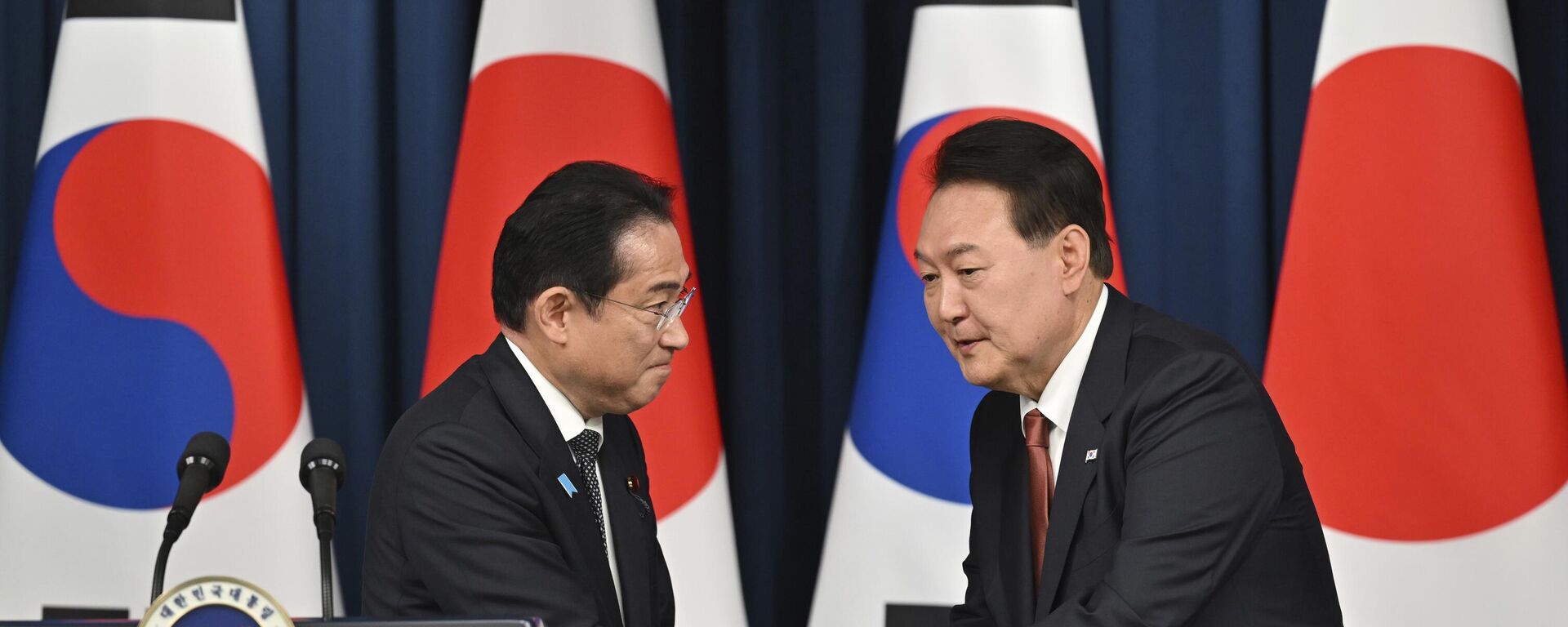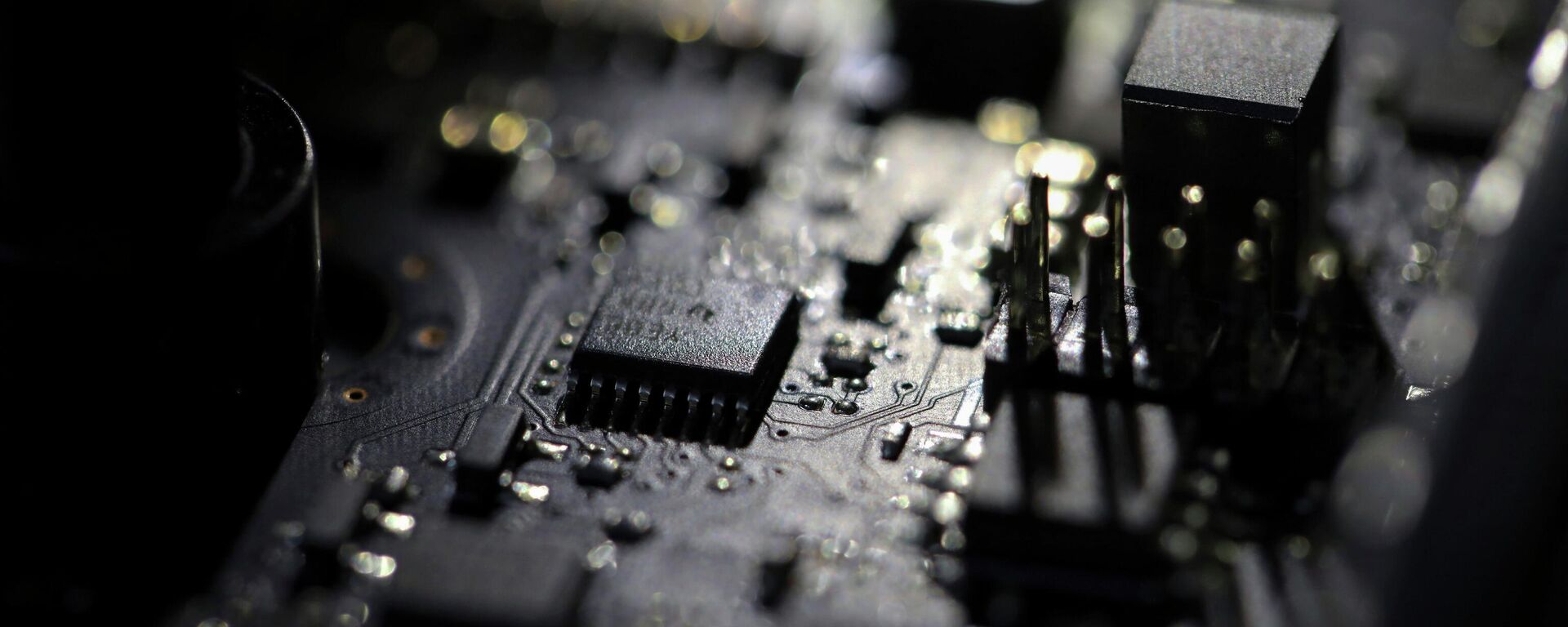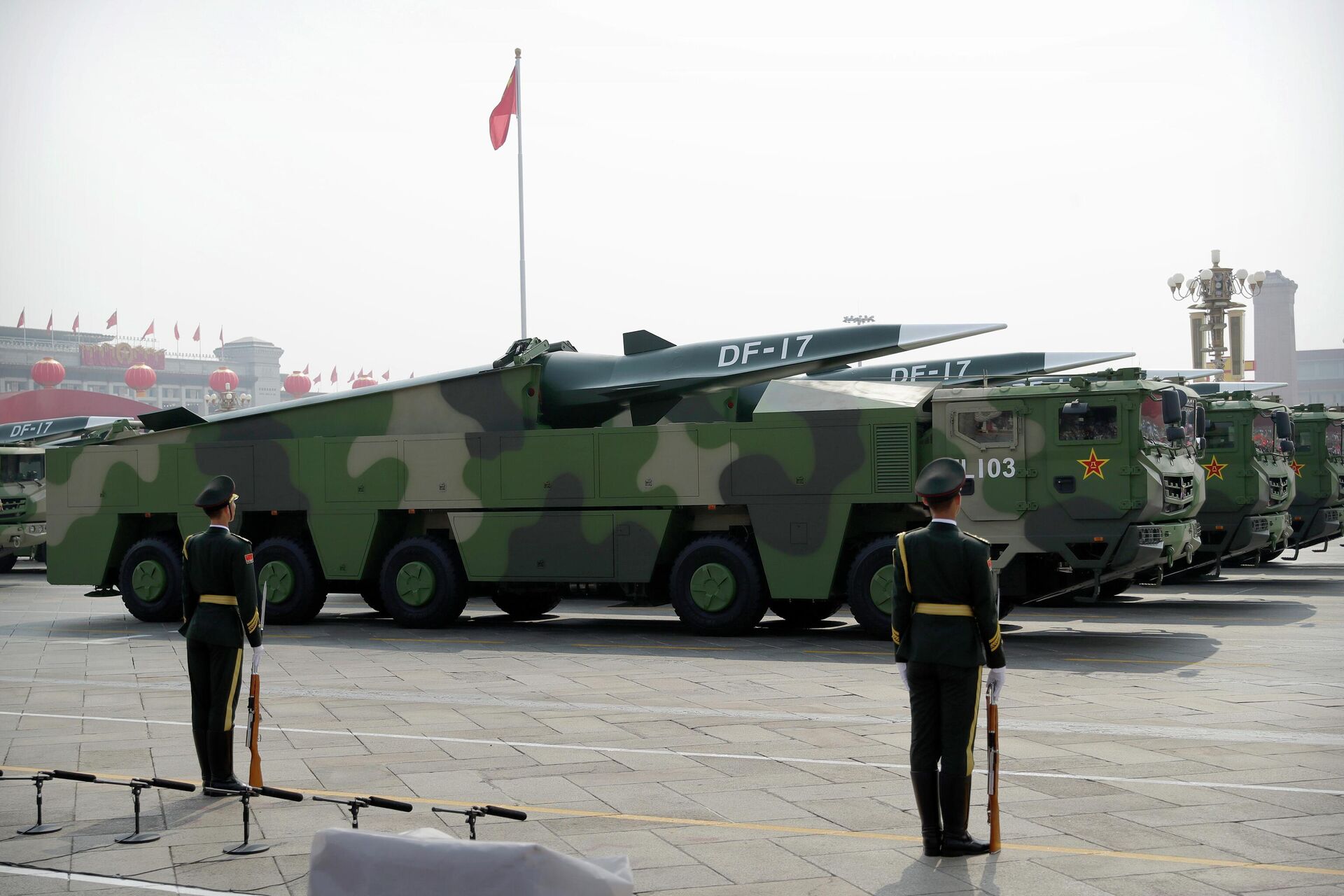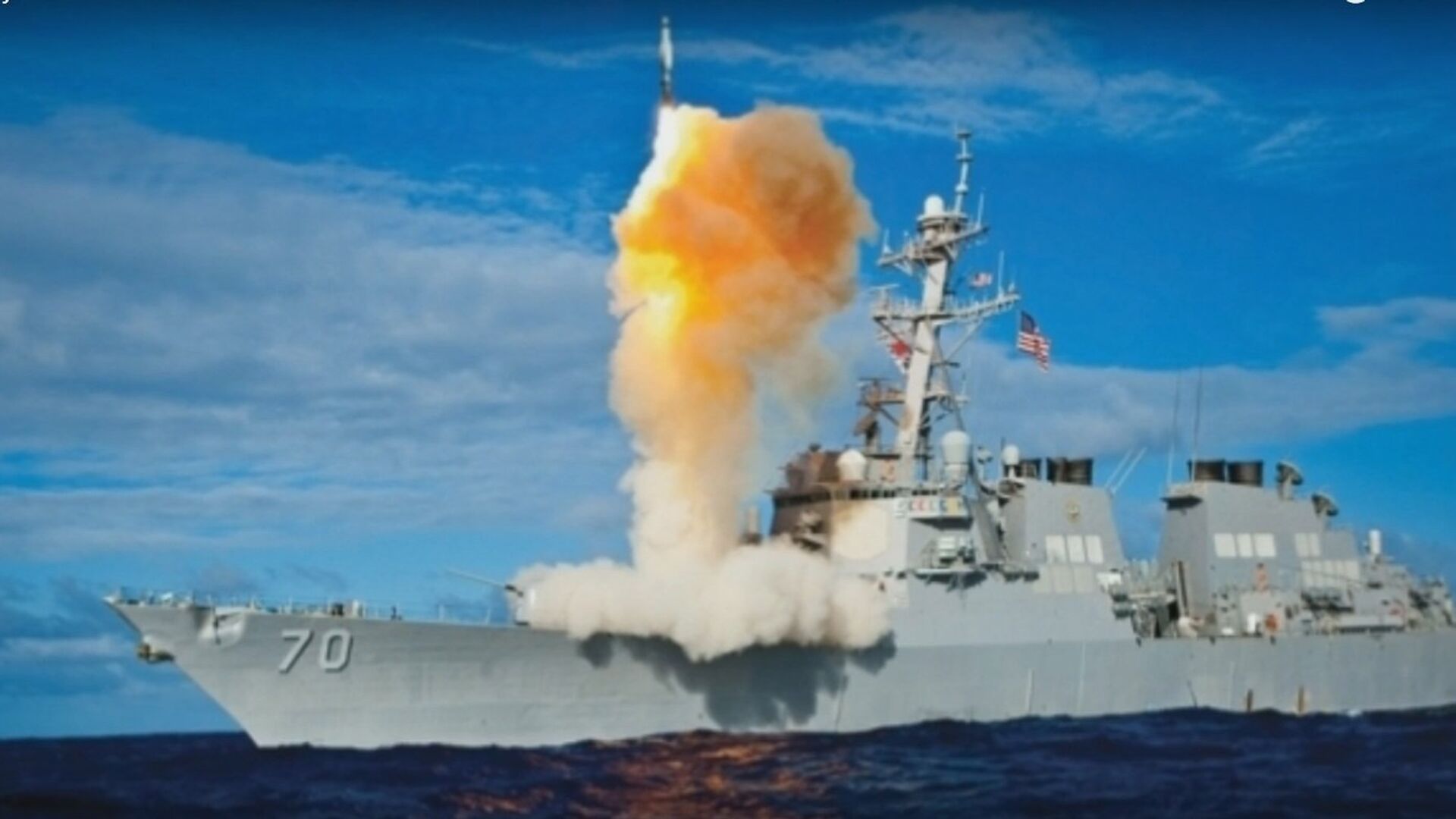https://sputnikglobe.com/20230818/us-japan-plan-for-hypersonic-interceptor-part-of-declining-empire-greasing-palms-overseas-1112711938.html
US-Japan Plan for Hypersonic Interceptor Part of Declining Empire ‘Greasing Palms Overseas’
US-Japan Plan for Hypersonic Interceptor Part of Declining Empire ‘Greasing Palms Overseas’
Sputnik International
A former Pentagon analyst told Sputnik that a forthcoming US effort to help Japan develop hypersonic missile defenses is little more than an attempt at shoring up the overseas periphery of a declining US empire.
2023-08-18T16:21+0000
2023-08-18T16:21+0000
2023-09-18T13:37+0000
karen kwiatkowski
japan
us
hypersonic missiles
interceptor
military
north korea
https://cdn1.img.sputnikglobe.com/img/105218/44/1052184416_10:0:1391:777_1920x0_80_0_0_b03bc8f79bc1262064b84ed353b05feb.jpg
The US and Japan are expected to announce a program to jointly develop a hypersonic missile interceptor as a counter to ultra-fast weapons unveiled by Russia, China, and the Democratic People’s Republic of Korea (DPRK) in recent years. The announcement is expected at a trilateral summit in Maryland to which US President Joe Biden has invited Japanese Prime Minister Fumio Kishida as well as South Korean President Yoon Suk-yeol, two of Washington’s strongest allies in East Asia.At the summit, Biden is expected to push the two countries to look beyond their troubled past - in which Korea was a brutally subjugated colony of the Japanese Empire - and join forces in yet another anti-China bloc in the Indo-Pacific region.The US and Japan have developed other anti-ballistic missile weapons before, but hypersonic weapons present a unique challenge since they are faster than most missile interceptors and have the unique ability to dodge and jink during their stealthy glide phase, making most intercept and even tracking attempts almost impossible.Retired US Air Force Lt. Col. Karen Kwiatkowski, a former analyst for the US Department of Defense, told Sputnik that the program is yet another gift to the military-industrial complex and is a move to strengthen the Pentagon’s presence in the region at a time when it’s increasing its pressure on China across multiple spectra.“It may be that due to decades of stagflation and an aging and shrinking population, Japan sees this as its only choice for a defense against potential missiles from North Korea and China. While a win for the massive defense industrial establishment in both countries, it represents no real change in the US approach to the emerging multipolar world - a kind of reactionary and politically narcissistic ‘global containment’ policy. George Kennan must be rolling over in his grave,” she said, referring to the mid-20th century US ambassador to the Soviet Union who authored the West’s Cold War-era anti-communist “containment” policy.“Along with the missile program, a Japan-US satellite constellation network to improve early warning and tracking will show results more rapidly,” she said, adding that “this surveillance capability will likely expand to include other US allies in the region, including the Philippines, as last year's election of Ferdinand Marcos, Jr. has resulted in a pro-US shift, and the US has been working to influence Thai politics as well.”Kwiatkowski noted that a major hurdle for developing a weapon capable of shooting down a hypersonic missile is that one needs to first develop hypersonic missiles, too - something the US has struggled to accomplish.By contrast to the lagging US program, Russia has three hypersonic weapons of various types in service, and China has at least two types of the ultra-fast weapons. The DPRK has announced several tests of such a weapon, but it’s unclear if the device is ready for deployment. Iran has also announced successful hypersonic weapons tests.“This ship/land-to-air missile is a nearly $1 billion Raytheon program, on the books for a few years now, and I would expect that the Japanese contribution is access to Pacific Ocean exercises and testing. This program, while defensive by description, will increase the ‘necessity’ for US Navy and Air Force presence in the Japan arena, which when considered with the again-growing US military presence in the Philippines will allow for Pentagon training and practice that triangulates with the South China Sea,” the former analyst said. “Japan has also made recent security and trade agreements with the newly elected pro-US Marcos Jr. government in Manila.”Kwiatkowski noted the “logical” statement by Russian President Vladimir Putin that by the time the US can develop a hypersonic interceptor, Russia will have invented something better. Russia was the first nation to develop hypersonic weapons, having been forced into devising a method to defeat the rapidly growing US ballistic missile defense network after Washington unilaterally abrogated the Anti-Ballistic Missile (ABM) Treaty in 2002.“I think the challenge for the rest of the world is how to peacefully coexist with the US security state as it processes through severe external and internal stresses, its poorly thought-out and irrational military goals, persistent poor political leadership, a cratering fiscal forecast, and a slow rise of anti-war populism at home,” Kwiatkowski said. “Unfortunately, this is a most dangerous time for everyone.”
https://sputnikglobe.com/20230818/bidens-trilateral-summit-with-south-korea-japan-aimed-at-accelerating-anti-china-policy-1112682339.html
https://sputnikglobe.com/20230818/japan-us-south-korea-to-agree-on-exchanging-data-on-semiconductor-shipments-1112701598.html
japan
north korea
Sputnik International
feedback@sputniknews.com
+74956456601
MIA „Rosiya Segodnya“
2023
News
en_EN
Sputnik International
feedback@sputniknews.com
+74956456601
MIA „Rosiya Segodnya“
Sputnik International
feedback@sputniknews.com
+74956456601
MIA „Rosiya Segodnya“
trilateral summit; japan; hypersonic interceptor; north korea; hypersonic weapons
trilateral summit; japan; hypersonic interceptor; north korea; hypersonic weapons
US-Japan Plan for Hypersonic Interceptor Part of Declining Empire ‘Greasing Palms Overseas’
16:21 GMT 18.08.2023 (Updated: 13:37 GMT 18.09.2023) A former Pentagon analyst told Sputnik that a forthcoming US effort to help Japan develop hypersonic missile defenses is little more than an attempt at shoring up the overseas periphery of a declining US empire with buckets of money for defense contractors.
The US and Japan are expected to announce a program to jointly develop a hypersonic missile interceptor as a counter to ultra-fast weapons unveiled by Russia, China, and the Democratic People’s Republic of Korea (DPRK) in recent years. The announcement is expected at
a trilateral summit in Maryland to which US President Joe Biden has invited Japanese Prime Minister Fumio Kishida as well as South Korean President Yoon Suk-yeol, two of Washington’s strongest allies in East Asia.
At the summit, Biden is expected to push the two countries to look beyond their troubled past - in which Korea was a brutally subjugated colony of the Japanese Empire - and
join forces in yet another anti-China bloc in the Indo-Pacific region.
The US and Japan have developed other
anti-ballistic missile weapons before, but hypersonic weapons present a unique challenge since they are faster than most missile interceptors and have the unique ability to dodge and jink during their stealthy glide phase, making most intercept and even tracking attempts
almost impossible.
Retired US Air Force Lt. Col. Karen Kwiatkowski, a former analyst for the US Department of Defense, told Sputnik that the program is yet another gift to the military-industrial complex and is a move to strengthen the Pentagon’s presence in the region at a time when it’s increasing its pressure on China across multiple spectra.
“What surprises me is the willingness of the Japanese to help fund such a program, over the 10-year development forecast of the new missile development, given past history of repeated failures and extensions seen in previous US ballistics missile defense programs in the Pacific,” Kwiatkowski said.

18 August 2023, 04:15 GMT
“It may be that due to decades of stagflation and an aging and shrinking population, Japan sees this as its only choice for a defense against potential missiles from North Korea and China. While a win for the massive defense industrial establishment in both countries, it represents no real change in the US approach to the emerging multipolar world - a kind of reactionary and politically narcissistic ‘global containment’ policy. George Kennan must be rolling over in his grave,” she said, referring to the mid-20th century US ambassador to the Soviet Union who authored the West’s Cold War-era anti-communist “containment” policy.
“Along with the missile program, a Japan-US satellite constellation network to improve early warning and tracking will show results more rapidly,” she said, adding that “this surveillance capability will likely expand to include other US allies in the region, including the Philippines, as last year's election of Ferdinand Marcos, Jr. has resulted in a pro-US shift, and the US has been working to influence Thai politics as well.”
Kwiatkowski noted that a major hurdle for developing a weapon capable of shooting down a hypersonic missile is that one needs to first develop hypersonic missiles, too - something the US has struggled to accomplish.
“Perhaps the US will concurrently successfully develop its own hypersonic missile. Lockheed Martin's aircraft-launched prototype, the Air-Launched Rapid Response Weapon (ARRW) was defunded, and the Pentagon seems to be looking at a ground-launched hypersonic cruise missile. A February 2023 Congressional Research Service study indicated that the services requested less than $5 billion for research in this area for FY2023, and double that at $11 Billion for FY2024. Perhaps this will be an area where AI will be used to simulate the latest Chinese or Russian hypersonic missile technology, which may continue to evolve and advance in coming years,” she said.
By contrast to the
lagging US program, Russia has
three hypersonic weapons of various types in service, and China has at least two types of the ultra-fast weapons. The DPRK has announced
several tests of such a weapon, but it’s unclear if the device is ready for deployment. Iran has also announced successful hypersonic weapons tests.
“This ship/land-to-air missile is a nearly $1 billion Raytheon program, on the books for a few years now, and I would expect that the Japanese contribution is access to Pacific Ocean exercises and testing. This program, while defensive by description, will increase the ‘necessity’ for US Navy and Air Force presence in the Japan arena, which when considered with the again-growing US military presence in the Philippines will allow for Pentagon training and practice that triangulates with the South China Sea,” the former analyst said. “Japan has also made recent security and trade agreements with the newly elected pro-US Marcos Jr. government in Manila.”
Kwiatkowski noted the “logical” statement by Russian President Vladimir Putin that by the time the US can develop a hypersonic interceptor, Russia will have invented something better. Russia was the first nation to develop hypersonic weapons,
having been forced into devising a method to defeat the rapidly growing US ballistic missile defense network after Washington unilaterally abrogated the Anti-Ballistic Missile (ABM) Treaty in 2002.

18 August 2023, 10:02 GMT
“Under rational circumstances, the Pentagon should be attempting to buy or steal hypersonic technology, rather than play continual catch-up, wasting years and billions of dollars,” she said. “Under moral and ethical circumstances, we should be taking care of Americans at home, rather than attempting to maintain a global empire using the neocon ideas, and our leftover and decaying military might of the 20th century. But any state, in its decline, takes care of itself and its friends first and last, and for the US this means greasing palms overseas and throwing another trillion or more into the pockets of the defense industrial complex (expanded to include the pharmaceutical and media industries) - which in turn does everything it can to elect the Congress and the president, to keep things profitable for them.”
“I think the challenge for the rest of the world is how to peacefully coexist with the US security state as it processes through severe external and internal stresses, its poorly thought-out and irrational military goals, persistent poor political leadership, a cratering fiscal forecast, and a slow rise of anti-war populism at home,” Kwiatkowski said. “Unfortunately, this is a most dangerous time for everyone.”







